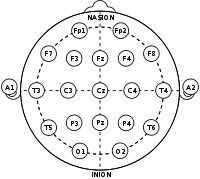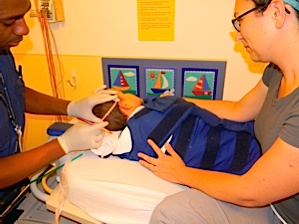10. Implications and applications#
Background and abstract#
Collecting electroencephalogram (EEG) on pediatric patients is a complex process. A standardized method has been developed - the 10-20 system - to collect EEG on patients, but this is easy to do on older patients that are able to sit still during the set-up process. Typically, parents have to ensure that their child is tired so they can cooperate during the set-up of the test (Ref). The current set-up is a manual process that involves measuring and marking spots on the head for electrode placement, a process that is not friendly for children.

10-20 standardized system of marking spots on a patient’s head for electrode placement. (Ref)


Left: child in EEG headnet (Ref). Right: Manual procedure of placing EEG electrodes. (Ref)
Current process#
Example of the EEG set-up process on a child at Harvard Boston Children’s Hospital, reference from Boston Children’s Hospital paper:
The process of setting up the electrodes on a patient’s head is a long process (this video is a timelapse of a video referenced from JoVE)
Examples of existing solutions#
EEG headcaps#
| Product name | Description of tool | Notes |
Braincap |
Has preset electrodes and wires on a knitted cap | Conductive gel needs to be applied to make electrode contact with scalp |
Tools to help with electrode placement#
| Product name | Description of tool | Notes |
| CapTrak | Handheld scanner that lights up places where EEG electrodes go | One still needs to mark spots on the head. Also doesn't hold electrodes in place |
Ultra-personalized product service system (UPPSS) concept and proposed technologies#
UPPSS concept#
| Product | Service |
| A conformable headcap that technologists who collect brainwave data can use on pediatric patients for quick and accurate placement of EEG electrodes during brainwave testing. The headcap can also be used to hold the EEG electrodes during the test. |
|
Proposed technologies#
For automatic mapping of electrodes - miniature robotics?#
Potential stakeholders#

Personalization at different levels#
- Children at the older end of the pediatric spectrum
- Autistic people
- Toddlers
- Premature babies - can also have an add-on that helps track head growth
- Children with uniquely shaped heads
How to manufacture#
- Medical grade materials and textiles will be pursued, to ensure solution complies with environment
- Stretch sensors will be used to give a live measurement for the head
- Electronics such as LEDs can highlight areas where electrodes are to be placed on the head
- Soft robotics/inflatables can be used to actuate the fitting of the electrodes
Things to do/address#
- Visual of concept
- How to manufacture? Materials, methods, involved parties?
- Project schedule
- Interview with EEG technologist
